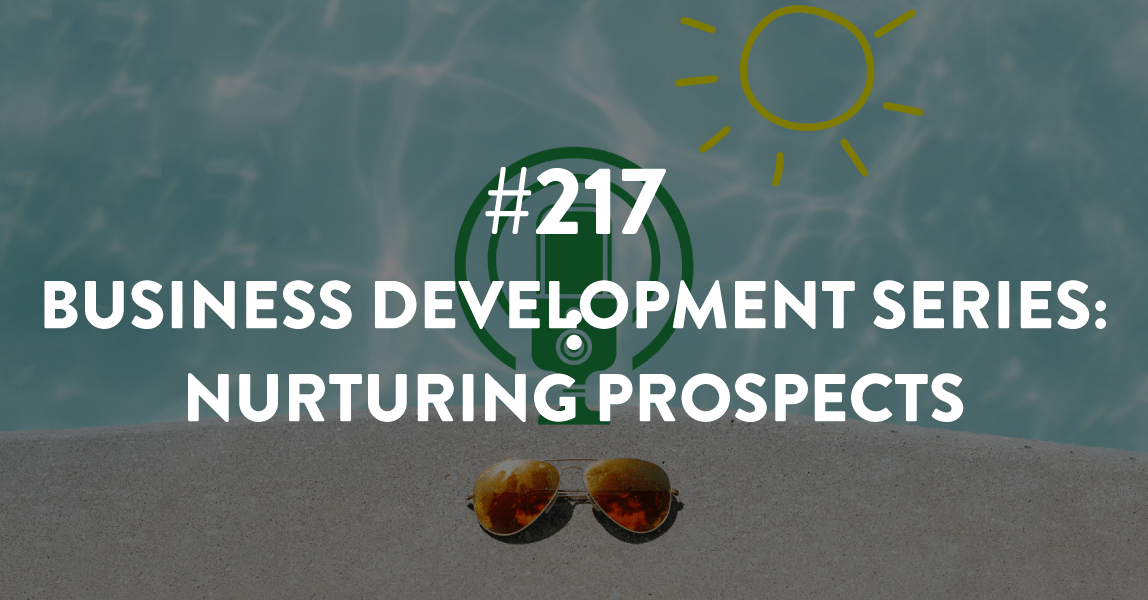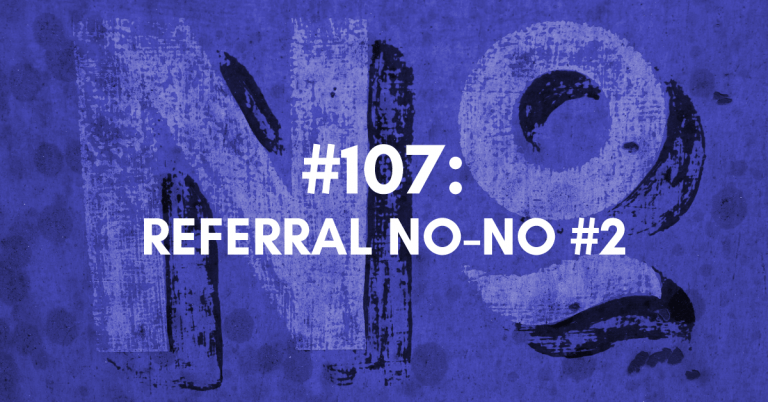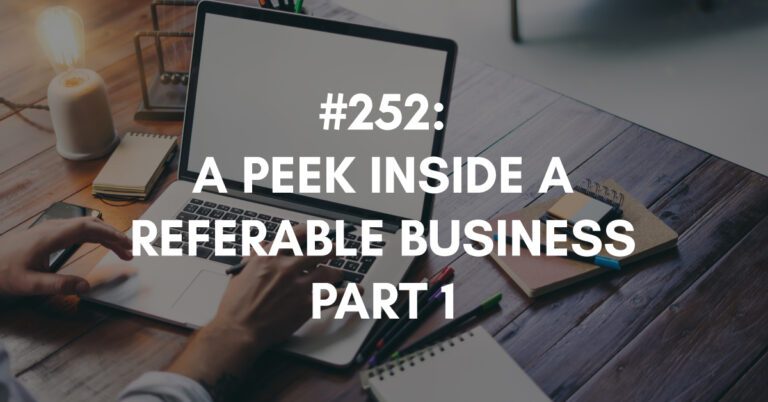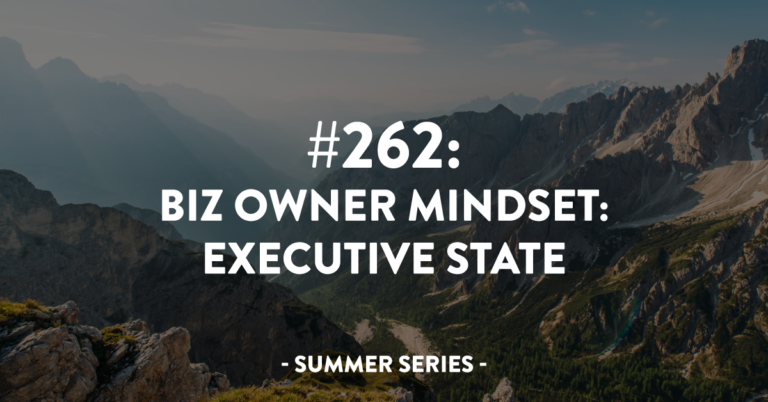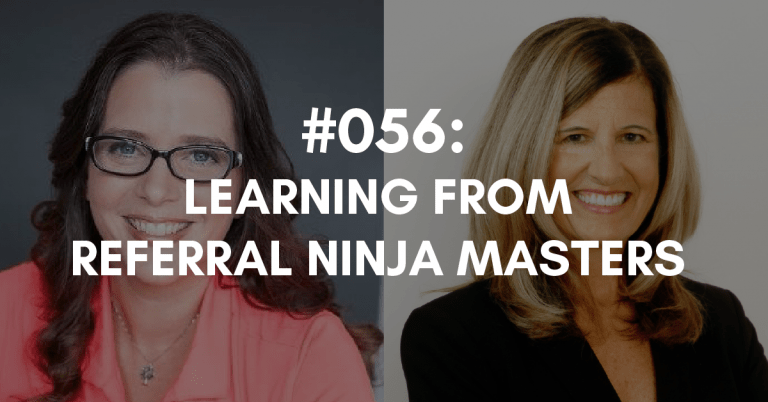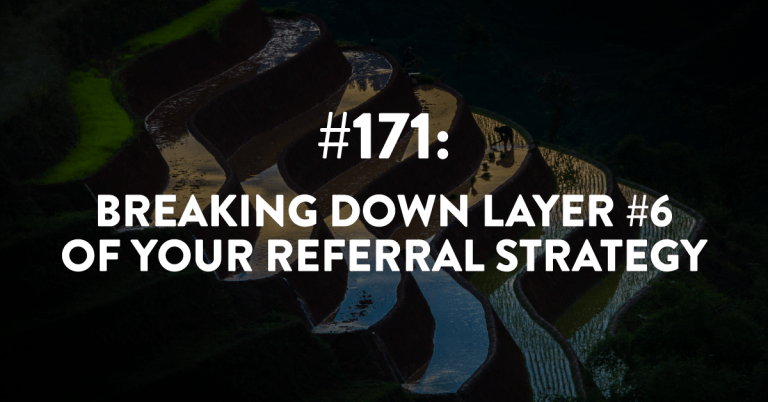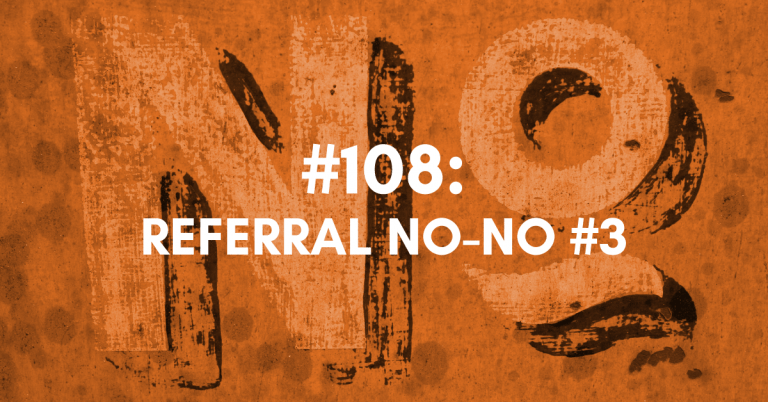Ep #217: Business Development Series: Nurturing Prospects
Although there are some prospects who will be a “Yes! I want to be your client!” quite quickly, some people may take a while to warm up – that’s where nurturing comes in.
Nurturing prospects is something that should be planned out from the beginning. You should be collecting data to understand the thought process your customers go through and the time it takes for them to come to a decision on whether they do want to work with you. Having this planned out from the start allows you to be prepared for every stage of your prospects’ purchasing journey.
So, what can you do to continue to nurture prospects when they aren’t quite ready to give you an answer? And how can you ensure that you remain present in their mind throughout their decision-making process? I’ll be answering these questions and more in this episode.
Links Mentioned During the Episode:
- Referral Ninja Roadmap Training – in 20 minutes you can learn the science and strategy behind generating referrals naturally… without manipulating, incentivizing or even asking.
Looking for Referral & Client Experience Resources:
Take the Referral Ninja Quiz to test your skills and abilities at generating referrals. (FREE)
Buy my book – Generating Business Referrals Without Asking – and learn how to generate referrals through my 5 steps. (LESS THAN $16)
Download the Building a Referable Business™ Roadmap to get a snapshot of the different strategies and tactics you need to deploy in your business to receive all the referrals you deserve! To snag the PDF, enter your name and email below.
Coming Up:
Next episode is #218, and we’re going to discuss if you’re a vitamin or medicine.
Download The Full Episode Transcript
Read the Transcript Below:
Stacey Brown Randall: Common outcomes from your sales process, of course, can be, “Yes, I want to be a client.” But they can also be, “No, not yet.” Well, and then of course, there’s the occasional ghosting of a client, of a potential client as well.
We’re going to dive into what it looks like in this episode, about nurturing those prospects if they don’t say yes right away.
You are not just another hustling salesperson. You are the expert, the
resource, the valuable partner for your clients, and how you grow your
business should reflect how your clients see you.Welcome to the Roadmap to Grow Your Business podcast. We generate
referrals without asking, build positive client experiences, and help
you take control of your business.
Here’s your charmingly sarcastic host, Stacey Brown Randall.
Stacey Brown Randall: Hey there, and welcome to episode 217 of the Roadmap To Grow Your Business Podcast. I’m your host, Stacey Brown Randall.
Okay, if you have not taken time to check out our new training, it’s a free 20-minute training. It’s called the Referral Ninja Roadmap, and it really dives into the science behind the methodology that I teach about generating referrals naturally, which means without manipulation, without incentivizing, and of course, without even asking. Then you need to go check out that training.
I will put the link in the show notes for this episode. Show notes page for this episode is staceybrownrandall.com/217. That’s 2-1-7 for episode 217, and Stacey has an E.
So, definitely go and check out that training. You can also go direct to staceybrownrandall.com/roadmap. And that’ll redirect you to the page where you can sign up to be able to watch our Referral Ninja Roadmap Training.
It really does give you a good overview of how what I teach is just different from most of the people out there teaching referrals.
And because yesterday was my birthday, it would be also an awesome birthday gift. If you went and downloaded to watch that training and then hit me up with an email and said what you thought about it.
Yep, I actually love receiving comments and thoughts and questions from you guys, once you really consume any of the training or resources that I put out there. But because it’s my birthday week, it would be even better to hear from you.
Of course, I would love to hear from you; questions and positivity. It is my birthday week after all. Just kidding, but I would love to hear from you on your thoughts or your questions that you have after you go through that training.
Alright, let’s move on. We are really getting close to wrapping up our business development series that has taken us from July (maybe the end of June), but through August with the business development series for our summer series. We’ve got a couple more things we have to talk about over the next couple of weeks before we wrap up.
Today’s episode is all about nurturing prospects, because the truth is sometimes at the end of your sales process, a client does say yes to becoming a paying client. And then sometimes, they don’t.
And so, this episode is all about what happens when they don’t say yes right away. So, when they come into your sales pipeline or your sales funnel, they come through the awareness phase, then they go through the buyer’s journey.
And then they come up the bottom and the close is not a yes, it is either a no or not yet. Or you just don’t really hear from them and you’re not a hundred percent sure what the answer was. Well, then they become a prospect that needs to be nurtured because the truth is not everybody’s going to be ready to buy the minute they learn about you.
Now, this is one of the reasons why I love getting prospects that are actually referred to me. And there’s been nothing in this series about referrals on purpose. I’ll be honest, I am kind of having withdrawals from talking about referrals. So, I’m like, “Once we get through the series, don’t worry, we’re going to go back to referrals.”
But this is one of the reasons why I actually love getting prospects that are referred to me, because I feel like when you have a referred prospect and what I’ve noticed with the people who are referred to me, for the most part, they take the process of learning about you and deciding to hire you more seriously.
And so, you get to the end of the process of them making the decision to work with you. And more than likely, it will be a yes when they’re referred to you, but not always.
But when they’re not going to say yes, because it’s a timing issue or something else has come up or whatever the reason is why you’re getting a, not yet. They typically tell you that. And that’s all because of the relationship they have with a person who referred them to you.
But I know that not every prospect that comes into your business is going to come through a referral source. The source of how all your prospects land in your funnel and go through your buyer’s journey isn’t going to be because they were referred to you.
So, it’s important that we understand what it looks like to nurture the prospects. But even when prospects are referred to you, it doesn’t mean they’re all going to say yes. And so, regardless if a prospect comes into your sales funnel and comes out with a not yet, whether they’re referred to you or not, there needs to be a nurturing process.
I did some data diving in my business, which you guys know, I talk a lot about the importance of data and what type of data you should be tracking, and that you should be paying attention to. I talk about this a lot on the podcast.
And one of the things that I think is the most valuable pieces of information within your business, outside of identifying number of referrals, number of referral sources, who’s active, who’s inactive, all those things— what sources are working to bring you clients and which aren’t; in addition to all of that, one of the things that I think is really, really important is understanding the timeline on which people say yes.
So, what I mean by that is there are some who say yes right away and maybe they say yes right away within 30 days. And then there are others who may be a part of your universe for months, maybe even years before the time is finally right for them to pull the trigger.
So, it’s important that we have a process in place to nurture those prospects while they are on their journey, making the decision of what it looks like to work with you.
So, I want you to think about this from that perspective of, it’s not like you’re having a process to nurture your prospects and it’s only going to run for 30 days if they didn’t say yes, and then it stops. This is truly a nurturing process with prospects.
One of the most valuable things I did in my business is actually go in and look at “Okay, when people don’t buy within the first 30 days of landing in my universe, how long does it take them to buy?”
It was really crazy to go in and the way that I actually collect information when people come into my business, I actually have all this information tracked within my CRM, within my Client Relationship Management tool.
So, to be honest, I don’t think I could have found all this information to recreate the data if I had to recreate it to get to this analysis. But because this is the stuff we track and it’s what my CRM sets up to track regardless, it made it really easy to do this.
But I was able to actually go in and be like, “Okay, from the minute someone comes into my universe and they don’t say yes within the first 30 days, how long does sometimes it takes folks to say yes.” And they were these points really within like the entire life cycle of a prospect, as to when they say yes.
And the shortest is usually, if they don’t say yes in the first 30 days, it’s within the first 90 days. And then sometimes, it’s not until eight months. And then we have another big trigger that happens at 14 months.
So, if you’re sitting there thinking, and you’re listening to this and you’re like, “Oh yeah, that was me. Like I heard about you, but then I didn’t join GBR or Building a Referral Business, BRB for like a year,” you’re probably in my 14-month range.
But there’s some that happen around that eight-month mark. And then there’s some that happen within that three-month mark.
And that’s really good information because what it tells me is that I have to have a way to continue to nurture those people so that when they are ready, they haven’t forgotten about me and go looking for somebody else to teach them about referrals, that they are ready to say yes to me. And so, having a process in place to nurture your prospects is really, really important.
Now, let me just first give a disclaimer before I dive into where nurturing starts and then, of course, talk about what it can look like. So, the disclaimer I want to give is this is for the folks who don’t give you a hard and fast, “No, don’t ever call me again. Don’t ever reach out to me again, I’m done with you.” Okay. That was really harsh, but I was trying to make a point.
So, there are the people who say yes, and become a client. And then there are some people who are like, “No, never.” Like for me, it would be someone saying, “I want to ask for referrals.” And then I’m like “Peace out.” Like we are not a match. So, I’m done communicating. You don’t need to hear from me because that would just be more noise in your inbox and nobody needs that.
So, I’m not talking about the people who told you flat out, “No, don’t ever talk to me again.” Or, “I don’t believe what you teach.” Or whatever. These are for the people that are like, “It’s not the right time.” Or, “I need some things to change first before I’m ready for this.”
And so, you get the, “not yet” answer. I think about one of my clients that I worked with last year, she had known me forever. But when she joined in January of last year, she specifically joined at that point, because prior to that, she had about eight months’ worth of work she needed to do to change the direction her company was headed and the type of client they were going after.
Because when she came into my world and worked with me and really wanted to understand how to get referrals for this new type of client she was going after, she wanted that understood and didn’t want to waste time. And she had huge results from what it looked like in terms of the ROI, because she had done some work first before she was ready to join my program.
And because of that, she was very locked and loaded and ready to go when it came time to join my program and got a massive … I don’t remember. It was like thousands and thousand percent ROI on her investment in my program.
So, when she first reached out and said, “I’m thinking about joining your program,” she then waited until she got some things right. And then joined.
So, there are people who are like, not yet, is a viable answer and it happens. And their reasoning for the not yet could have a lot of things to do. Maybe it’s not financially the right time for them. Maybe they don’t actually have the time. Maybe it’s something that needs to be solved in their business or fixed in their business before they do it.
In some cases, they just can’t decide, which also puts them in the “not yet” category. I was having a conversation with one of my best friends in business. And she said, “I’m so tired of making big, scary decisions.” And I was like, “That’s because all your big scary decisions involve a crap ton of money.” And she’s like, “Yep.”
So, if you were to come along and have something she needed, she’s not making a big, scary investment decision right now, because she’d made so many. Doesn’t mean there’s not value or she wouldn’t see value in what you do, it just means that she’s not at a place where she would even want to entertain the idea.
So, you don’t know exactly where all your prospects are when you’re meeting them. And there’s a lot behind the scenes that they’re not telling you as they go through the process of deciding if they want to hire you.
So, the not yet answer can be loaded and have a lot of things to it. It could also be that they just haven’t made a decision. So, it’s not like it’s “No, not yet or no, forever.” It’s just more of a, “I don’t know.” And so, “I’m still trying to figure this out if this is the decision that I want to make.”
So, regardless, nurturing of prospects starts when they don’t say yes, they didn’t commit. They have their reasons for not committing. And you now want to nurture that relationship, so basically, they don’t forget about you when it does come time to make a decision to hire someone who does what you do that they’re remembering to hire you.
So, where the nurturing begins, I believe that it begins at the very end of your interaction where they make a decision. So, when they make a decision to say like really like, “No.” Or, “Yes.” Obviously, if they make decision to say yes, they become like a client. But if you’re having conversations and they haven’t made a decision, maybe it’s too soon for them to make a decision.
But at the end of a conversation that you’re having with them, and a lot of times this can be the very first conversation you’re having with them. At the end of that conversation, they need to make a decision. And maybe that decision is to learn more. It could also be to make a decision to say yes or no. I think the nurturing begins at that point. Others may say it’s at different moments.
But for me, I always think about your prospect in my active part of my process. You’re in the active part of my buyer’s journey. And I’m definitely nurturing you while you’re in that, because you’re going through the active part of my sales process.
But once we get to the point where you don’t really say yes, and you’re more of a, “No, we’re not yet, or I need to think about it,” at that moment, I want to set some expectations and I want to set some expectations about what my follow-up will look like and what I would like from you when I do follow up.
Sometimes that’s, “Hey, if you want to first do, I don’t know, XYZ, before you make a decision, would it be good if I followed up with you a week from now? Is that enough time?”
So, the first thing to do is to set expectations of what the nurturing will actually look like if they’re still in a place of making a decision, but they didn’t say yes on the spot. And then eventually, you go into more, long-term nurturing as well.
So, think about this as like short-term nurturing when you’re getting them to a yes or when they’re just not sure and they need a little bit more time. You’ve got a nurturing process in that short-term.
And then once they’ve really said, “Hey, I’m not doing it,” then you have some long-term nurturing for those that you think could come back around and work with you in the future.
So, what can nurturing then actually look like? Well, a lot of it will actually depend on how your sales process unfolds.
So, financial advisors, they will have a process where maybe it takes three meetings before they meet the people, decide they want to do the next step, which is really when a bunch of information has to be sent over so that a financial plan can be put together. Then it’s presenting that and then it’s, “Hey, do you want to move forward with this?”
And now, that can depend on how a lot of different things work. Sometimes financial plans are paid for, sometimes they’re not. So, there is a whole bunch, I just kind of like glossed over in that world, using that as my example. But there are some industries where there’s like a one to two, three meeting expectation of what it looks like. And their sales process is very uniform to that.
For others, if you’re thinking about a real estate agent, it can be hey, you’re thinking about listing your house and I’m going to go on a listing presentation. I may have a conversation with you on the phone, gather the information I need, then show up at your house, do a listing presentation about how I’m the agent for you.
Obviously, that would probably more than likely happen if you weren’t referred to them. And then they have to make a decision on which listing agent they’re going to go with. So, maybe it’s a one meeting and then the decision is made.
So, where nurturing begins has a lot to do with your sales process and how it actually unfolds. And then of course, how long you want to extend it. It also has to do with, if your sales happens more on the local level versus the national level versus the international level.
There may be more like direct follow up that happens at the local level versus like a business like mine that’s working with business owners in multiple, almost a dozen countries all around the world. There’s not a lot of direct follow-up happening there. It’s going to be more like the email stuff, or it’s going to be like a drip campaign that’s happening via email.
There’s a lot of variables ultimately is what I want you to think about in terms of what your nurturing process looks like. So, when you think about your nurturing process, think about how your sales process unfolds. Think about when they get to the end of your sales process and the decision is, “Not yet” or, “I have to think about it.”
Then think about, okay, well, are the people that I’m working with, like a real estate agent on a local level or are they on a national level, like they could be anywhere in the country or anywhere in the world, on an international level, and then how you would do follow up from there.
And then of course, you have things like direct follow-up, which maybe that’s phone calls. Maybe that’s direct emails from you, direct phone calls from you, could also be maybe getting on Zoom meetings.
And then of course, there’s these things that it’s referred to in the industry as drip campaigns, which are typically emails that are sent out, but they’re not like direct, they’re typically being sent out by some type of email provider or some type of software provider.
And those have different tactics as well. Direct follow-up is different from having somebody on a direct campaign. And that’s not to say you wouldn’t use them interchangeably.
I use a mix. If I’ve had a conversation with someone about joining one of my programs, and at the end of the process, they’re like, “Hey, this is not the right time for me, follow back up with me in September,” then I have a process of what that looks like, so that I will get on my calendar to follow back up with them.
And in the meantime, they’ll be on the drip campaign. And that’s really my weekly emails that come out that are talking about something referral-specific are talking about something that’s happening on the podcast. And then obviously, it’ll say in September to follow back up with them, and that would be on my calendar and that would be a direct follow up.
So, there’s different things you can deploy. I have found that I just like to test things and try things out just to see what ultimately works and what ultimately happens. There’s lots of great ideas out there in terms of what it can look like to nurture prospects.
But I do believe that some type of ongoing communication with people who haven’t decided to say yes, but may say yes in the future, is important.
And so, whatever that looks like for you, if you’re more on the automated side and you want that to be a newsletter that you write and then goes out on a weekly or monthly basis, if you want that to be more direct.
And so, all your follow-up happens because you’re calendaring tasks in your calendar or in your project management software to remind you that it’s time to follow up with somebody.
Most important thing is to make sure you just don’t forget about your prospects. Because most of the time what people do is you didn’t say yes. Okay, moving on to the next person to see if they’ll say yes, and then I forget about you.
When in reality that person could come back around, like in my case, at the three-month mark or at the eight-month mark, or even at the 14th month mark, and I want to be available and ready to welcome those folks in whenever they are ready for it.
So, we think it’s important that you understand what you’re nurturing process looks like. So, can you send through things through the mail? Yes. Can you make phone calls? Yes. Can you send emails? Of course.
There’s a lot of delivery mechanisms or delivery vehicles to consider, but most importantly, is actually what you’re saying in your follow-up and what that ultimately looks like. And that is something you’re going to have to spend a little bit of time on figuring out what that looks like for you.
And it’s really important that you spend some time on that. So, you’re not just constantly churning through potential clients. And then when they say, no, you’ve kind of ignored them. And there’s not a chance for them to come back around because you’re not communicating with them anymore.
But if you’re also setting those expectations that ongoing communication will happen, like, “Hey, I’ll follow up” or, “You’ll start getting our newsletters.” Letting them know and saying that expectation in the beginning, I think is really important so they know what’s going to happen.
And if they are still interested, you’ll know it because they won’t unsubscribe. They’ll keep receiving your information. I mean, maybe they’ll even follow up and ask questions as you go through nurturing them until eventually, they come back around, hopefully, as a paying client.
Doesn’t mean they all will, but having a process to nurture your prospects is very, very important.
So, you may have to sit down with a piece of paper and do a little brain dump if you don’t have this process in place and figure out what it’s going to look like for you, and then test it.
If you don’t think anyone’s responding or receiving your emails, then test something different. Maybe send something through the mail. There’s different things that you can do in that regard.
So, really good thoughts here for you to think about in terms of what you need to do when it comes to prospecting; understanding where does the nurturing start and what can it look like? And then what should you keep in mind based on how your sales process unfolds, the area in which you sell; locally, nationally, internationally.
And then of course, the types of follow-ups being drip campaigns, more passive, like emails you’re sending, or that direct follow-up you’re doing; like a specific email from you, a specific phone call, a specific text from you.
Hopefully, this was helpful and you can sit down and have a conversation with yourself about what your follow up should look like.
And for some of you who are listening and be like, “Yep, I do all that.” Now, it’s time to reassess, well, is it working? Is it working to actually cultivate those prospects and nurture those prospects the way you want to? And if not, maybe it’s time to consider changing things up.
Okay, remember the show notes page for this episode is staceybrownrandall.com/217 for episode 217. Stacey has an E. And that’s also where you can find the link to our latest and greatest training.
It is free. You can go watch it on our website, it is the Referral Ninja Roadmap. It’s only 20 minutes and I dig into the science behind my methodology. So, you can understand why it’s possible to generate referrals naturally, without asking, without manipulation, and without paying for them.
Alright, next week, it’s episode 218, and we’re going to discuss if you’re a vitamin or medicine. Have no idea what I’m talking about? Well, then you’re just going to have to come hang with me next week when we talk about it.
Until then, you know what to do; take control and grow your business. Bye for now.
Thanks for listening to the Roadmap to Grow Your Business podcast. To
access all resources and links mentioned in today’s show, and to
connect with Stacey, head over to www.staceybrownrandall.com.

